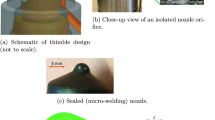Abstract
Emission standards have grown increasingly stricter, consequently triggering greater interest in issues surrounding environmental pollution. In particular, soot and NOx released from DI diesel vehicles is considered to be the main source of air pollution in urban environments. However, the mechanics of fuel spray formation and the influence of the operating parameters on the resulting spray flame are not yet fully understood. In this study, the original KIVA code was modified to incorporate a detailed chemical reaction mechanism involving various species and multiple reaction steps to better understand the spray characteristics. n-Heptane, C7H16, was used as the representative fuel for diesel fuel, and the reaction mechanism for this fuel was composed of 66 species and 274 elementary reaction steps. The accuracy of the predicted results was demonstrated primarily by a comparison with experimental results. The numerical prediction of a specific operating condition for the parametric investigation correlates well with the experimental results.
Similar content being viewed by others
References
Abani, N., Kokjohn, S., Park, S. W., Bergin, M., Munnannur, A., Ning, W., Sun, Y. and Reitz, R. D. (2008). An improved spray model for reducing numerical parameter dependencies in diesel engine CFD simulations. SAE Paper No. 2008-01-0970.
Amann, C. A. and Siegla, D. C. (1982). Diesel particulateswhat they are and why. Aerosol Science and Technology, 1, 73–101.
Amsden, A. A. (1997). KIVA-3V: A Blocks-Structured KIVA Program for Engines with Vertical or Canted Valves. Los Alamos National Laboratory LA-13313-MS.
Azimov, U. B., Kim, K. S., Jeong, D. S. and Lee, Y. G. (2009). Evaluation of low temperature diesel combustion regimes with n-Heptane fuel in a constant volume chamber. Int. J. Automotive Technology 10,3, 265–276.
Bockhorn, H. and Schäfer, T. (1994). Growth of Soot Particles in Premixed Flames by Surface Reactions, Soot Formation in Combustion. Springer.
Ciezki, H. and Adomeit, G. (1993). Shock-tube investigation of self-ignition of n-Heptane-air mixtures under engine relevant conditions. Combustion and Flame 93,4, 421–433.
Curran, H. J., Gaffuri, P., Pitz, W. J. and Westbrook, C. K. (1998). A comprehensive modeling study of n-Heptane oxidation. Combustion and Flame, 114, 149–177.
Golovitchev, V. I., Nordin, N., Jarnicki, R. and Chomiak, J. (2000). 3-D diesel spray simulations using a new detailed chemistry turbulent combustion model. SAE Paper No. 2000-01-1891.
Karlsson, A., Magnusson, I., Balthasar, M. and Mauss, F. (1998). Simulation of soot formation under diesel engine conditions using a detailed kinetic soot model. SAE Paper No. 981022.
Karlsson, J. A. J. (1995). Modeling Auto-Ignition, Flame Propagation and Combustion in Non-stationary Turbulent Sprays. Ph. D. Dissertation. Charmers University of Technology. Sweden.
Koss, H. J., Wiartalla, A. and Backer, H. (1993). Spray Propagation, Mixture Formation, Auto-ignition and Soot Formation of Multi-Component Fuels in a Pressure Chamber. IDEA-EFFECT 2nd Periodic Report. 515-542.
Lindstedt, P. R. (1994). Simplified Soot Nucleation and Surface Steps for Non-Premixed Flames. Soot Formation in Combustion. Springer.
Magnussen, B. F. and Hjertager, B. H. (1976). On mathematical modeling of turbulent combustion with special emphasis on soot formation and combustion. 16th Int. Symp. Combustion, The Combustion Institute, Pittsburgh, 719–729.
Nordin, N. (2001). Complex Chemistry Modeling of Diesel Spray Combustion. Ph. D. Dissertation. Dept. Thermo and Fluid Dynamics. Chalmers University of Technology. Sweden.
O’Rourke, P. J. (1981). Collective Drop Effect on Vaporizing Liquid Sprays. Ph. D. Dissertation. Princeton University. New Jersey.
Peters, N. (1984). Laminar diffusion flame models in nonpremixed turbulent combustion. Progress in Energy and Combustion Science, 10, 319–339.
Pope, S. B. (1985). PDF methods for turbulent reactive flows. Progress in Energy and Combustion Science, 11, 119–192.
Song, B. H., Kim, G. S., Choi, Y. H. and Rhee, B. O. (2006). Numerical simulation of chemically reacting laminar and turbulent flowfields using preconditioning scheme. J. KSME 30,4, 320–327.
Subramanian, G., Vervisch, L. and Ravet, F. (2007). New developments in turbulent combustion modeling for engine design: ECFM-CLEH combustion sub-model. SAE Paper No. 2007-01-0154.
Van Leer, B. (1979). Towards the ultimate conservative difference scheme. V — A second-order sequel to Godunov’s method. J. Computational Physics, 32, 101–136.
Wiartalla, A., Backer, H., Koss, H. J. and Bruggemann, D. (1992). Influence of Spray Development and Fuel Quality on Soot Formation and Oxidation. IDEA Report.
X. Shi, G. Li, and L. Zhou (2007). DI diesel engine combustion modeling based on ECFM-3Z model. SAE Paper No. 2007-01-4138.
Yasar, O. (1998). A scalable model for complex flows. Int. J. Computers & Mathematics with Applications, 35, 117–128.
Author information
Authors and Affiliations
Corresponding author
Rights and permissions
About this article
Cite this article
Song, B.H., Seo, J.W. & Choi, Y.H. Numerical investigation of a DI diesel spray flame using a detailed chemical reaction mechanism. Int.J Automot. Technol. 13, 365–372 (2012). https://doi.org/10.1007/s12239-012-0034-3
Received:
Revised:
Accepted:
Published:
Issue Date:
DOI: https://doi.org/10.1007/s12239-012-0034-3




